Bedford
In 1750, Robert MacRay established a trading post in the region which would one day become Bedford County. Life on the frontier was full of turmoil, a result of hostilities between the British & French. Raids and attacks from hostile Indians, allies of the French, eventually pressured MacRay to abandon his Raystown outpost.
In 1759, the British ousted the French from Fort Duquesne. In preparation, a new road was cut to Raystown and toward the French stronghold. A new garrison at Raystown was named Fort Bedford. The captured French fortification was renamed Fort Pitt. The new road west was transformed from a network of Indian trails to become known as the Forbes Road. Later, this evolved onto a toll road, or turnpike, providing direct access across the state.
Following the defeat of the French and with the expectation of greater safety afforded by Fort Bedford, the area soon began to increase in population. Pioneers used Forbes road to reach and settle in the lush valleys and timber-rich mountains. However, outlying communities, such as Saxton, still experienced the dangers of the frontier. Casualties from the Indian conflicts were frequent as late as 1780.
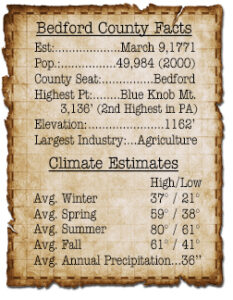 Fort Bedford and the surrounding area grew as a transportation and lodging center because of its strategic location on the major route through PA. In 1794, the Nation’s first President, George Washington, stayed at the Espy House in Bedford. The President’s arrival was in response to one of the Country’s first tax crisis, the Whiskey Rebellion.
Fort Bedford and the surrounding area grew as a transportation and lodging center because of its strategic location on the major route through PA. In 1794, the Nation’s first President, George Washington, stayed at the Espy House in Bedford. The President’s arrival was in response to one of the Country’s first tax crisis, the Whiskey Rebellion.
The discovery of curative spring waters and the establishment of the Bedford Springs Hotel, lured the wealthy and influential to Bedford during the 19th century. President James Buchanan used the hotel as his summer White House. It was here that our President received the first trans-Atlantic telegram, sent by Queen Victoria, from England.
Presidents Hayes, Garfield, and Benjamin Harrison also stayed at the Springs, as did famous Kentuckian, Henry Clay.
With an excellent combination of agriculture and commerce, early industry also flourished in the county. As the colonies pushed for independence, coal was discovered in the Broad Top. Iron foundries were established in Hopewell around 1800.
Rail service between Huntingdon and Bedford expanded the transportation industry carrying coal, timber, and iron. Passengers also used the service to commute or for touring points of interest along the line.
The second half of the 19th century was a time of prosperity in the County, with population increasing almost 100% between 1870 and 1890.Many of the area’s attractive homes and Victorian neighborhoods were built during this time. The Huntingdon and Broad Top Railroads steamed between the mines, foundries, and coal fields. The picturesque route crossed the Raystown Branch of the Juniata River at several sites, such as the crossing at Mountain Rose Beach. Passengers could enjoy a trip through wooded mountains and fertile fields with stops at locations with colorful names like Cypher Station.
Transportation services continued in importance with auto and truck traffic using the Lincoln Highway (Route 30 ) and the new Pennsylvania Turnpike. The Interstate highway system brings an ever growing stream of traffic to the County via I-76, I-70, and I-99. For many travelers, Bedford County is an easy place to visit, but a difficult place to leave.
Breezewood
Some call it “The Travelers Oasis” … some call it “The Gateway to the South” or even, “The Town of Motels” … there are many names to define Breezewood, PA. All of them center around one thing. Breezewood is a town that is built to serve the traveler.
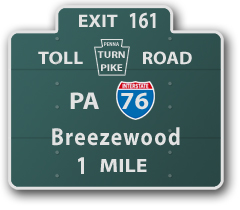 With easy access to the PA Turnpike (I-76 / I-70), Interstate Route 70 and Route 30, Breezewood provides easy access from Washington D.C, Baltimore, Pittsburgh, Harrisburg, and other major cities.
With easy access to the PA Turnpike (I-76 / I-70), Interstate Route 70 and Route 30, Breezewood provides easy access from Washington D.C, Baltimore, Pittsburgh, Harrisburg, and other major cities.
Breezewood, PA started out as a quiet farming area, with one small store, post office and a schoolhouse. With the development of the Lincoln Highway (Route 30) and the Pennsylvania Turnpike, it has become a bustling center of the travel trade. Breezewood, PA is now called the “Gateway to the South”. Built on the travel industry, Breezewood offers convenience of location … easy access to major highways like the PA Turnpike, I-70 and Route 30.
Many service facilities, such as hotels, gas stations and restaurants are located near the Turnpike entrance and the entrance to Interstate 70.
In the beginning…
Breezewood is truly a result of a crossroads of highways. But before Breezewood existed, there was a settlement to the east of present Breezewood called Rays Hill (or Nycumtown). John Nycum had bought this piece of land in 1820, later building a small store.
In 1836, he succeeded in establishing the Rays Hill Post Office and served as Postmaster for quite some time. His son Simeon built the first mill in the township, a tub mill. John started a tannery in 1836. On the western edge of present-day Breezewood was the Maple Lawn Inn, estimated to be about 200 years old. The 22 room building was used as a stage coach stop, and still stands today. The foundation is several feet thick, and the building is 3 to 4 bricks thick.
By 1900, a small settlement of houses had formed in the valley between these two areas. A group of citizens decided on a name for the village so that a post office could be created. If it was a windy day, it would explain the name Breezewood. There were two stores, both to the west on the hill leading to the Maple Lawn Inn. The “main street” is US Route 30, six lanes wide for its trip through what is known locally as “the strip”.
Route 30 started as an Indian path, was widened to a packhorse trail, then was improved to a wagon road by British General Forbes – the Forbes Road. From 1814-1821 it was part of the Chambersburg-Bedford Turnpike, a private toll road. It was named The Lincoln Highway in the 1930’s as the first nationwide project to pave a highway.
In 1940, the Pennsylvania Turnpike, the nation’s first super highway, was completed with an interchange at Breezewood, connecting with Route 30. This started making changes in what became known as “the Town of Motels”. But Breezewood’s real boom came after Interstate 70 was built, using the existing PA Turnpike to travel west. I-70 travelers had to enter the Turnpike to continue west, and turnpike travelers needed to exit at Breezewood if they were using I-70 East.
This intersection led to another nickname – “Gateway to the South” – because I-70 led to Baltimore, Washington, D.C., and on south. This intersection of three major routes has caused major motel chains, most fast food and restaurant chains, and local businesses, to congregate in this mile-long stretch of highway in a village of approximately 100 people.
The Mt. Zion Lutheran Church (and its cemetery) is the only structure that still remains from before the Turnpike construction began. It was built in 1856, and sits at the eastern edge of the strip. The first tourist business to open was the Gateway Motel and Restaurant. This was built in 1941, just after the turnpike opening, by Merle Snyder.
Thanks to Jennifer Wichterman for her input!
Bedford Springs
Just south of Bedford, PA is the Omni Bedford Springs Resort & Spa, which was once known as the Bedford Springs Resort. The resort hotel built near the springs was renowned throughout the 1800’s and 1900’s for its peaceful setting and elegance. What began as a hotel to house health conscious patrons in the early 1800’s continued to develop into one of the country’s top resort hotels.
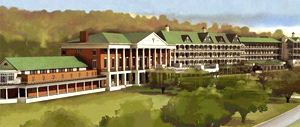 Dr John Anderson began construction of the Bedford Springs Hotel in 1804, completing the hotel in 1806. The first hotel building was built mostly of native stone. From this first wing, the hotel grew each year with new additions. Two adjoining sections, the Swiss Building and the northernmost Colonnades were completed in 1840.
Dr John Anderson began construction of the Bedford Springs Hotel in 1804, completing the hotel in 1806. The first hotel building was built mostly of native stone. From this first wing, the hotel grew each year with new additions. Two adjoining sections, the Swiss Building and the northernmost Colonnades were completed in 1840.
The Colonnade is built in Ante-Bellum architecture, perhaps to appeal to the many Southerners who were frequenting the spa.
The Bedford Springs Hotel was built to serve the many visitors to the area who were coming to drink the curative waters of the Bedford Springs. These visitors were often patients of local doctors, including Dr. John Anderson and Dr. William Watson who prescribed a regimen of diet, exercise and many, many pints of the springs water. These patients, who were wealthy enough to travel great distances to come to the Bedford Springs would also welcome a resort hotel where they could stay as they restored their health.
As the hotel grew in size and reputation, it served as host to a number of U.S. Presidents, including James Buchanan, Zachary Taylor, James K. Polk, William Henry Harrison.
There are many other famous guests that we could name but some of the most unusual guests were enemies of the United States. The Bedford Springs Hotel “hosted” nearly 200 Japanese Diplomats who were captured in Germany after Germany’s surrender. These Prisoners of War were kept at the Springs until the end of the war with Japan. Officials were concerned that the local Bedford population would resent the Japanese being kept there, so they put out notices that the Japanese Ambassadors would not have use of the golf course and would not have access to liquor. The Bedford food supply would not be imposed upon to feed these prisoners. Food would be supplied by Washington D.C.
The Bedford Springs had already been helping with the US war effort, serving as a radio training school for the US Navy from 1942 through 1945. Over 7,000 sailors were trained here, with banquet hall full of radio equipment, the convention hall turned into classrooms. A number of men have visited us here at the Bedford County Visitors Bureau Office and commented to us about their experiences at the Radio Operator School. One ex-navy radioman commented, “We sat down for lunch one day and a guy draped a linen napkin over my lap. This wasn’t exactly standard dining procedure in Navy chow halls and I wasn’t sure if I liked that or not.”The Bedford Springs Hotel, one of the most visible landmarks of the region’s past 200 years, received new hope when restoration of the facility to new glory was announced at a ceremony on the front lawn of the historic landmark in 2005. The Bedford Springs Resort re-opened to guests in July 2007 as the Bedford Springs Resort & Spa. In January 2009, the resort became known as the Omni Bedford Springs Resort & Spa, when Omni Hotels became the long term operator.
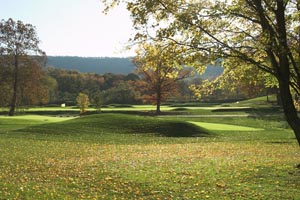 The 18 hole Golf Course received a lot of care and attention from the new operators of the Bedford Springs Resort during their renovations in 2006/2007. Overlooking breathtaking views of the Allegheny Mountains and Cumberland Valley, this remarkable course spans the work of three golf architectural masters—Spencer Oldham, A.W. Tillinghast, and Donald Ross. The total renovation was overseen by noted classic golf course restoration architect Ron Forse, restoring it to its original course layout. A round of golf on these historically significant tees will be a must-play for golf enthusiasts of all levels.
The 18 hole Golf Course received a lot of care and attention from the new operators of the Bedford Springs Resort during their renovations in 2006/2007. Overlooking breathtaking views of the Allegheny Mountains and Cumberland Valley, this remarkable course spans the work of three golf architectural masters—Spencer Oldham, A.W. Tillinghast, and Donald Ross. The total renovation was overseen by noted classic golf course restoration architect Ron Forse, restoring it to its original course layout. A round of golf on these historically significant tees will be a must-play for golf enthusiasts of all levels.
To see the Bedford Springs Resort official web site, click here.
For more information about the history of the Bedford Springs, I recommend the book (shown above) by Ned Frear. The book is 74 pages and sells for $10.00.
Epsy House
What is the significance of the Espy House?
The Espy House served as President Washington’s Headquarters during the Whiskey Rebellion in 1794. The building is located in downtown Bedford, on Pitt Street. Although it is now used as a bakery and apartments, it was originally built by Colonel David Espy in 1766.
What exactly was the “Whiskey Rebellion”?
If you’re like me … you may remember studying about the Whiskey Rebellion in school. The general impression that I garnered was that, apparently a lot of drunks around our area didn’t feel like paying an extra penny for a glass of whiskey, so they rebelled against the tax by beating up government officials. This is not accurate. Here’s a concise rundown on what happened and why …
On March 3rd, 1791, the Congress in Philadelphia passed the federal excise tax on whiskey. However, farmers on the western frontier (Bedford to Pittsburgh area), didn’t have currency to pay a tax. They would boil their grains down to whiskey because it was easier to transport this “cash crop” than the grains themselves. To these farmers, whiskey was their money. They could trade for furs, salt, meat, etc.
So, when tax collectors came around, these farmers refused to pay. The farmers didn’t believe that the government had a right to “steal” money that they themselves had earned. They beat the tar out of tax collectors and threatened those who represented the government.
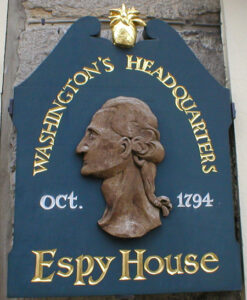
For President Washington, the question was this … “Does the government have the right to pass and enforce law … including the imposition of a tax?” President Washington concluded that the Government had passed a legal tax and believed that if the Whiskey Rebellion rebels succeeded in opposing the tax by force, they would show the US Government to be weak and unable to enforce its own laws. And from there, it was a short step to the collapse of the United States.
On September 19th, 1794, the first Present of the United States became the only President to ever lead troops into battle. He led over 12,000 men, “The Constitutional Army” to quell this rebellion. It was decided that President Washington would lead the troops as far west as Bedford.
Why was the Espy House chosen as Washington’s Headquarters?
In 1794, it was the nicest house in town. Where else should the President of the United States stay when he comes to visit Bedford County?
Why was the Whiskey Rebellion (and its final outcome) so important in our history?
The significance of the Whiskey Rebellion, in the broad sweep of history is that it proved the viability of the Federal Constitutional Government of central powers. To put it in plainer words, Washington determined that the government had the right to pass law and the right (and resolve) to enforce those laws. He demonstrated this through his actions during the Whiskey Rebellion.
George Washington’s address on October 20 1794 to General Lee at Bedford, PA as Washington was preparing to return to Philadelphia.
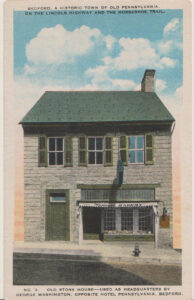
George Washington’s address on October 20 1794 to General Lee at Bedford, PA as Washington was preparing to return to Philadelphia.
To Henry Lee Esq. Commander in Chief of the Militia Army, on its march against the Insurgents in certain Western Counties of Pennsylvania Espy House – Bedford Pennsylvania
Sir, Being about to return to the seat of Government, I cannot take my departure without conveying through you to the Army under your command the very high sense I entertain of the enlightened and patriotic zeal for the constitution and the laws which has led them so cheerfully to quit their families and homes and the comforts of private life to undertake and thus far to perform a long and fatiguing march and to encounter and endure the hardships and privations of a Military life. Their conduct hitherto affords a full assurance that their perseverance will be equal to their zeal and that they will continue to perform with alacrity – whatever the full accomplishment of the object of their march shall render necessary. No citizens of the United States can ever be engaged in a service more important to the Country. It is nothing less than to consolidate and preserve the blessings of that Revolution which at much expense of blood and treasure constituted us a free and independent Nation. It is to give to the world an illustrious example, of the utmost consequence to the cause of mankind. I experience a heart-felt satisfaction in the conviction that the Conduct of the troops throughout will be in every respect answerable to the goodness of the cause and the magnitude of the stake. There is but one point on which I think it proper to add a special recommendation. It is this, that every officer and soldier will constantly bear in mind that he comes to support the laws and that it would be peculiarly unbecoming in him to be in any way the infractor of them – that the essential principles of a free government confine the provinces of the Military to these two objects – Ist to combat and subdue all who may be found in arms in opposition to the National will and authority; 2nd to aid and support the civil Magistrate in bringing offenders to justice – The dispensation of this justice belongs to the civil Magistrate and let it ever be our pride and our glory to leave the sacred deposit there unviolated. Convey to my fellow citizens in arms my warm acknowledgments for the readiness with which they have seconded me in the most delicate and momentous duty the chief Magistrate of a free people can have to perform and add my affectionate wishes for their health comfort and success – Could my further presence with them have been necessary or compatible with my civil duties at a period when the approaching commencement of a session of Congress particularly urges me to return to the seat of Government; it would not have been withheld. In leaving them I have the less regret, as I know I commit them to an able and faithful director; and that this director will be ably and faithfully seconded by all.
G. Washington
Cox Monument
The Cox Monument near Blue knob
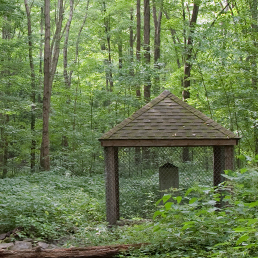 The story of the Lost Children of the Alleghenies is the heart wrenching tail of two brothers, Joseph, age 5, and George, age 7, who became lost after wandering away from their Spuce Hollow home near Blue Knob on April 24, 1856.
The story of the Lost Children of the Alleghenies is the heart wrenching tail of two brothers, Joseph, age 5, and George, age 7, who became lost after wandering away from their Spuce Hollow home near Blue Knob on April 24, 1856.
Hundreds of people unsuccessfully searched for the boys for two weeks. It was then said that a local farmer by the name of Jacob Dibert had a series of three reoccurring dreams about finding the children. After communicating his dreams to his wife, and brother-in-law, Harrison Whysong, who lived in the Pavia area, the two men set out to retrace the clues of his dream.
On May 8th as they set out to follow the signs of his dream, they came across a dead dear, a small shoe, a log fell across a stream, and a birch tree with a broken top. Just as Jacobs dream had predicted, the children were found at the base of the birch tree dead from exposure.
To commemorate the 50th anniversary of the Cox Children story, the community of Pavia took up donations for a monument to be erected at the site where George and Joseph were found. The monument was officially dedicated in 1910. In 2007 country singer Allison Krauss recorded a song entitled “Jacob’s Dream” written by written by Julie Lee and John Pennell, which tells the story The Lost Children of the Alleghenies.
To Visit the Cox Monument, head to Blue Knob State Park and take Monument Road to see the memorial for yourself.
Cox Monument Location

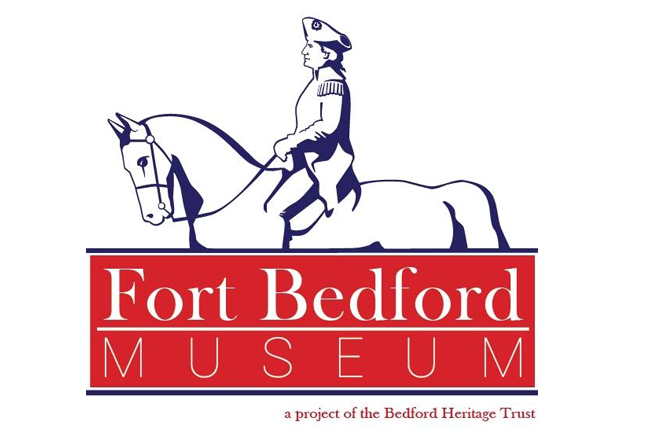
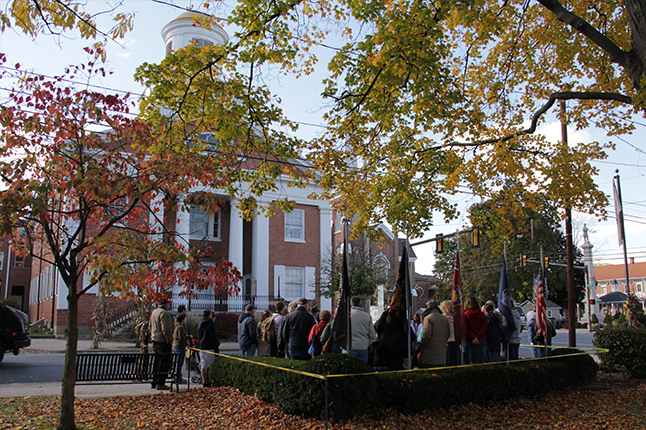

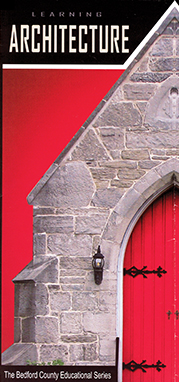
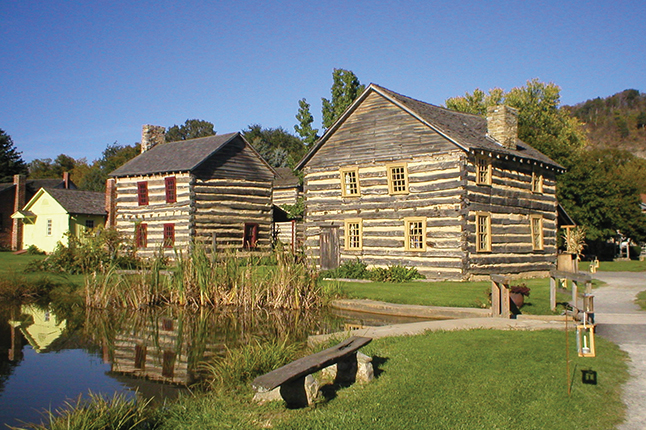

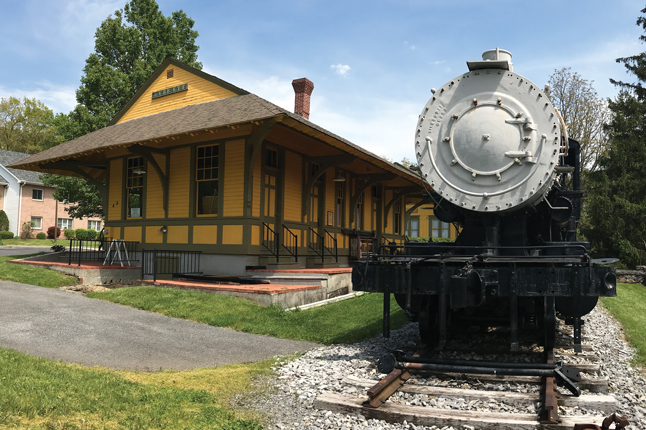
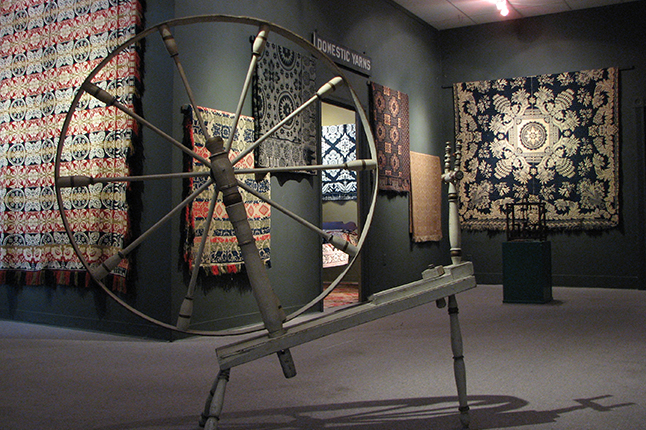
 Fort Bedford and the surrounding area grew as a transportation and lodging center because of its strategic location on the major route through PA. In 1794, the Nation’s first President, George Washington, stayed at the Espy House in Bedford. The President’s arrival was in response to one of the Country’s first tax crisis, the Whiskey Rebellion.
Fort Bedford and the surrounding area grew as a transportation and lodging center because of its strategic location on the major route through PA. In 1794, the Nation’s first President, George Washington, stayed at the Espy House in Bedford. The President’s arrival was in response to one of the Country’s first tax crisis, the Whiskey Rebellion. With easy access to the PA Turnpike (I-76 / I-70), Interstate Route 70 and Route 30, Breezewood provides easy access from Washington D.C, Baltimore, Pittsburgh, Harrisburg, and other major cities.
With easy access to the PA Turnpike (I-76 / I-70), Interstate Route 70 and Route 30, Breezewood provides easy access from Washington D.C, Baltimore, Pittsburgh, Harrisburg, and other major cities. Dr John Anderson began construction of the Bedford Springs Hotel in 1804, completing the hotel in 1806. The first hotel building was built mostly of native stone. From this first wing, the hotel grew each year with new additions. Two adjoining sections, the Swiss Building and the northernmost Colonnades were completed in 1840.
Dr John Anderson began construction of the Bedford Springs Hotel in 1804, completing the hotel in 1806. The first hotel building was built mostly of native stone. From this first wing, the hotel grew each year with new additions. Two adjoining sections, the Swiss Building and the northernmost Colonnades were completed in 1840. The 18 hole Golf Course received a lot of care and attention from the new operators of the Bedford Springs Resort during their renovations in 2006/2007. Overlooking breathtaking views of the Allegheny Mountains and Cumberland Valley, this remarkable course spans the work of three golf architectural masters—Spencer Oldham, A.W. Tillinghast, and Donald Ross. The total renovation was overseen by noted classic golf course restoration architect Ron Forse, restoring it to its original course layout. A round of golf on these historically significant tees will be a must-play for golf enthusiasts of all levels.
The 18 hole Golf Course received a lot of care and attention from the new operators of the Bedford Springs Resort during their renovations in 2006/2007. Overlooking breathtaking views of the Allegheny Mountains and Cumberland Valley, this remarkable course spans the work of three golf architectural masters—Spencer Oldham, A.W. Tillinghast, and Donald Ross. The total renovation was overseen by noted classic golf course restoration architect Ron Forse, restoring it to its original course layout. A round of golf on these historically significant tees will be a must-play for golf enthusiasts of all levels.

 The story of the Lost Children of the Alleghenies is the heart wrenching tail of two brothers, Joseph, age 5, and George, age 7, who became lost after wandering away from their Spuce Hollow home near Blue Knob on April 24, 1856.
The story of the Lost Children of the Alleghenies is the heart wrenching tail of two brothers, Joseph, age 5, and George, age 7, who became lost after wandering away from their Spuce Hollow home near Blue Knob on April 24, 1856.